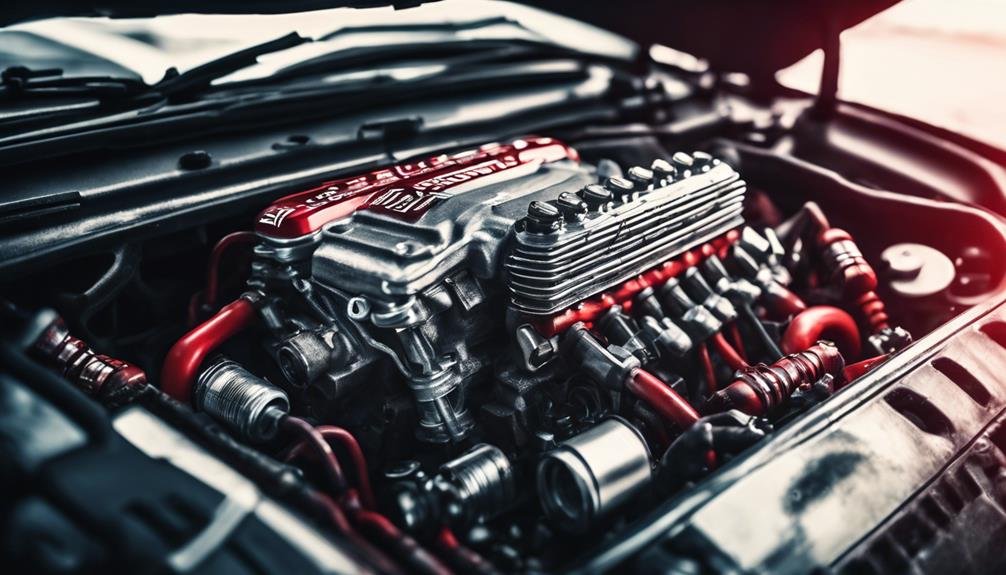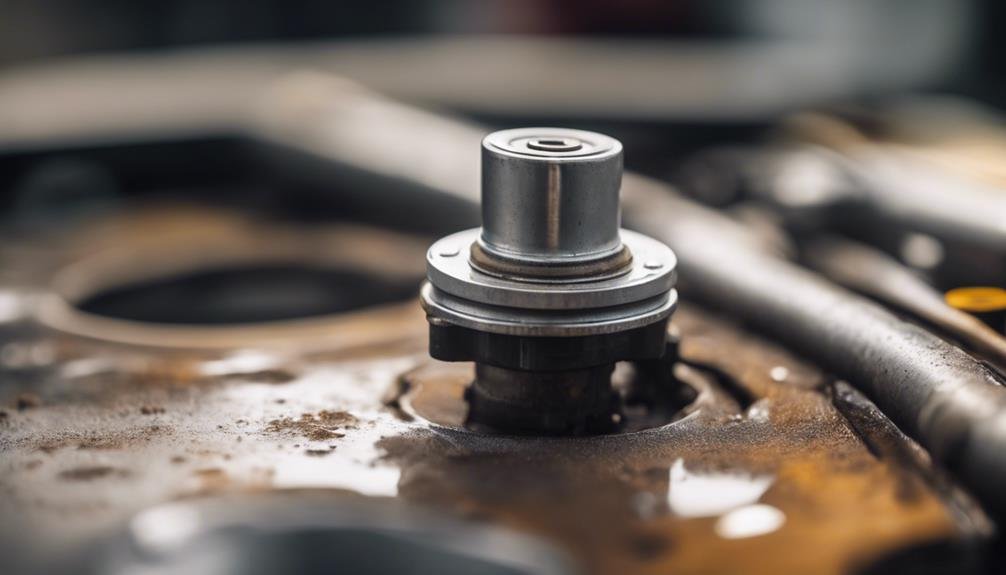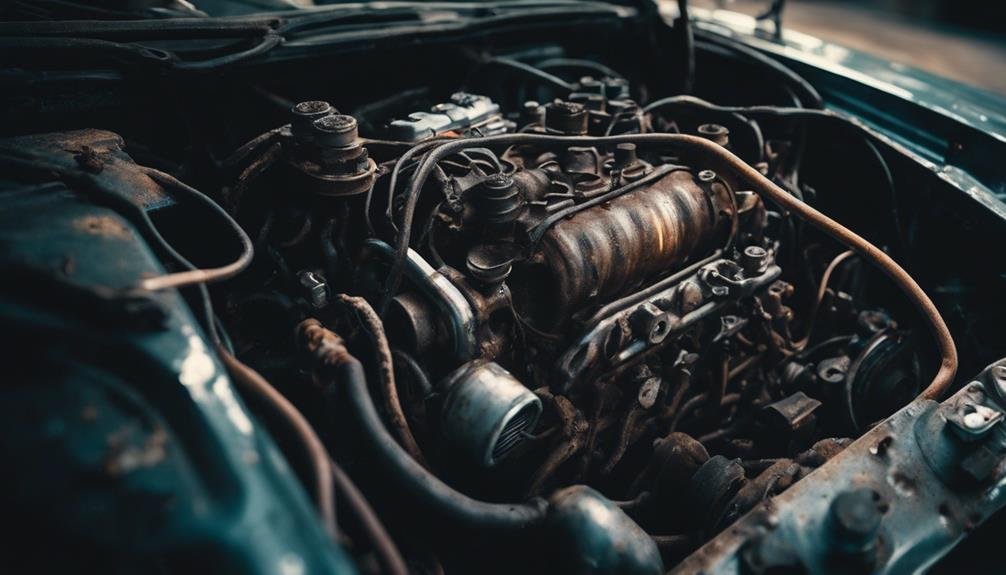If your engine is misfiring, rough idling, or struggling to start, a faulty crankshaft position sensor might be the cause. This sensor plays a vital role in synchronizing fuel injection and ignition timing, and a faulty one can lead to poor fuel efficiency, difficulty starting the engine, and illumination of the check engine light. Other symptoms may include frequent stalling, engine misfires, and decreased fuel efficiency. If you're experiencing these issues, it's important to diagnose and replace the faulty sensor to avoid further engine damage. Continuing to investigate the causes and solutions will help you understand the problem more thoroughly.
Key Takeaways
- A faulty crankshaft position sensor can cause engine misfires, leading to decreased engine performance and potential damage.
- Rough idling and difficulty starting the engine are common symptoms of a faulty crankshaft position sensor.
- A malfunctioning sensor can disrupt fuel injection and ignition synchronization, resulting in poor fuel efficiency.
- Ignoring the issue can lead to poor fuel efficiency and potential engine damage.
- An illuminated check engine light may indicate a faulty crankshaft position sensor.
What Is a Crankshaft Position Sensor
When you delve into the world of engine management, you'll soon realize that a crankshaft position sensor is a key component that plays a pivotal role in ensuring your engine runs smoothly and efficiently. Located near the crankshaft, this sensor monitors the position and speed of the crankshaft, providing critical data to the engine control unit.
This data is essential for determining fuel injection timing and ignition timing, which directly impact engine performance. In fact, a faulty crankshaft position sensor can lead to starting problems, misfires, and poor fuel economy.
By ensuring the sensor is functioning correctly, you can maintain excellent engine function, which is crucial for a smooth and efficient driving experience. Regular maintenance and timely replacement of a faulty sensor are necessary to prevent these issues.
Early Warning Signs of Failure
You'll often notice early warning signs of a faulty crankshaft position sensor, including illuminated check engine lights, difficulty starting the engine, or frequent stalling. These symptoms can be frustrating, but they're important in alerting you to a potential problem.
A faulty crankshaft position sensor, or CKP, can cause your engine to run rough, leading to engine misfires and decreased fuel efficiency. If you're experiencing any of these issues, it's vital to have your CKP sensor checked and potentially replaced to avoid further engine damage.
A failing CKP sensor can also cause your engine to stall frequently, which can be a safety hazard, especially when driving on busy roads. By recognizing these early warning signs, you can take proactive steps to address the issue before it leads to more severe problems.
Illuminated Check Engine Light

An illuminated check engine light on your dashboard is frequently the initial indication that your crankshaft position sensor is malfunctioning.
This warning indicator shouldn't be ignored, as it signals potential problems with the sensor that can lead to more severe engine problems if left unchecked.
When the check engine light illuminates, it's vital to give it your attention, as it's a warning sign that something is amiss.
Ignoring it can result in further engine issues that can be costly and time-consuming to repair.
The check engine light serves as a warning indicator for potential problems with the sensor, and prompt attention to it can prevent more severe engine problems from developing.
It's important to address the issue promptly, as neglecting it can have serious consequences for your vehicle's performance and longevity.
Engine Performance Issues
As you drive, a faulty crankshaft position sensor can cause your engine to misfire, idle rough, and lose power, making it difficult to maintain a smooth ride. This is because the Crankshaft Position Sensor (CKP) plays a vital role in synchronizing the fuel injection and ignition system, ensuring peak engine performance.
A bad crankshaft sensor can disrupt this synchronization, leading to engine misfires, rough idling, and a decrease in overall engine performance. These symptoms can be frustrating and affect your driving experience. Additionally, ignoring these symptoms can result in poor fuel efficiency and potential engine damage.
It's crucial to address these issues promptly to prevent costly repairs and maintain peak engine performance. By recognizing the symptoms of a faulty crankshaft position sensor, you can take proactive steps to replace the sensor and safeguard your engine's health. Regular maintenance and prompt sensor replacement can help prevent costly repairs and ensure peak engine performance.
Hard Starting and Stalling Issues

Every time you turn the key, a faulty crankshaft position sensor can make it a struggle to get your engine running, leading to hard starting issues that can be frustrating and inconvenient. You may find yourself turning the key multiple times, waiting for the engine to roar to life, only to be met with silence.
This hard starting issue is often accompanied by stalling problems, where the engine shuts off unexpectedly while driving, leaving you stranded. A faulty crankshaft position sensor (CKP) is often the culprit behind these issues. The sensor's faulty readings can prevent the engine from getting the right amount of fuel and spark, making it difficult to start or maintain a steady idle.
If you're experiencing hard starting and stalling issues, it's crucial to address them promptly to prevent further engine damage. A proper diagnosis and replacement of the faulty sensor can resolve these problems, getting your engine running smoothly once again. Don't let a faulty CKP leave you stranded – prioritize diagnosis and replacement to ensure your engine runs smoothly and efficiently.
Rough Engine Idling and Misfires
When your engine idles rough, stumbling along with unstable RPMs and vibrations, it's likely that your crankshaft position sensor is to blame. A faulty Crankshaft Position Sensor (CKP) can cause rough engine idling, characterized by unstable RPMs and vibrations, making your car's engine performance suffer.
Misfires, where the fuel isn't properly ignited, can also occur, further compromising engine performance. The CKP's failure to accurately detect the crankshaft's position leads to misfires and erratic engine behavior. As a result, you may experience decreased engine performance, and if left unchecked, potential damage to your engine.
Additionally, these symptoms can trigger the check engine light to illuminate, indicating a problem with the CKP. It's important to address these issues promptly to prevent further damage. By recognizing the signs of a faulty CKP, you can take corrective action to restore your engine's performance and prevent costly repairs down the road.
Decreased Fuel Efficiency Problems

Your car's decreased fuel efficiency is another telltale sign that your crankshaft position sensor might be failing, and it's likely that you'll notice it in your wallet. When your sensor is faulty, it can disrupt the fuel injection timing, leading to poor combustion and decreased fuel efficiency.
This means your engine is consuming more fuel than it needs, resulting in reduced fuel economy. The crankshaft position sensor plays a critical role in adjusting fuel injection timing, which is vital for best fuel economy. When the sensor provides inaccurate timing information, it can lead to poor combustion, further decreasing fuel efficiency.
As a result, you may notice your fuel costs increasing, and your car's performance suffering. Monitoring and addressing issues with the crankshaft position sensor can help improve overall fuel efficiency, saving you money and reducing your carbon footprint.
Common Causes of Sensor Failure
Heat, electrical issues, and mechanical stress can all contribute to crankshaft position sensor failure. Understanding these causes is key to preventing or repairing sensor problems.
You might be surprised to learn that a bad crankshaft position sensor can be caused by something as simple as overheating engine temperatures. When your engine gets too hot, the sensor's plastic covering can melt, leading to failure.
Circuitry issues, such as faulty voltage or damaged wiring, can disrupt signal transmission, causing problems. If you've got a broken timing belt, it can directly impact the functionality of the crankshaft position sensor, leading to issues.
Extreme heat from the engine can also damage the sensor housing, causing sensor failure. Normal wear and tear associated with engine use can also cause damage to the sensor over time.
Diagnosing a Faulty Crankshaft Sensor

Now that you understand the common causes of sensor failure, it's time to investigate the telltale signs of a faulty crankshaft position sensor and how to diagnose the problem. Diagnosing a faulty crankshaft sensor involves a combination of visual inspection, testing the output signal, and comparing it to a known good sensor.
| Diagnostic Step | Description |
|---|---|
| Visual Inspection | Check for signs of damage, corrosion, or wear on the sensor and its connections |
| Testing Output Signal | Use diagnostic equipment to test the sensor's signal and compare it to the manufacturer's specifications |
| Comparing Output Signal | Compare the output signal to a known good crankshaft position sensor to determine if replacement is necessary |
| Specialized Tools | Use specialized tools, such as oscilloscopes, to test the sensor's output signal |
| Correct Installation | Make sure correct installation of the new sensor, consulting the vehicle's service manual for compatibility |
Replacing a Bad Crankshaft Sensor
When swapping out a faulty crankshaft sensor, you'll need to select a replacement that's compatible with your vehicle's make and model. Make sure to choose the correct sensor type for your vehicle's year and model, as specified in your owner's manual or the manufacturer's website.
Before installing the new sensor, inspect the wiring harness connected to the sensor for any damage or wear, and replace it if necessary. Consult your vehicle's service manual for proper installation instructions and ensure compatibility with the new sensor.
Replacing a faulty crankshaft sensor can help prevent engine misfires, rough idling, and other performance issues. By properly diagnosing and replacing a bad crankshaft sensor, you can improve engine starting, fuel efficiency, and overall engine performance.
Remember to follow the manufacturer's guidelines for installation and troubleshooting to ensure a successful replacement. By doing so, you'll be able to restore your vehicle's peak performance and avoid costly repairs down the road.
Frequently Asked Questions
What Happens When a Crankshaft Sensor Goes Bad?
"When your crankshaft sensor goes bad, you'll likely experience frustrating issues, such as difficulty starting the engine, rough idling, and decreased fuel efficiency, which can be really inconvenient and affect your daily commute."
What Are the 7 Symptoms of a Bad Camshaft Position Sensor?
You'll notice 7 distinct symptoms when your camshaft position sensor goes bad, including a check engine light, difficulty starting, stalling, rough idling, misfires, reduced fuel efficiency, and potential safety risks if ignored.
How Do I Know if My Crankshaft Is Bad?
You'll know your crankshaft is bad if you notice unusual engine noises, excessive vibration, or scoring on the crankshaft itself; also, look for signs of overheating, oil leaks, or abnormal engine performance.
Will a Crankshaft Sensor Cause Misfire?
You're wondering if a crankshaft sensor can cause a misfire, and the answer is yes, it can! A faulty sensor can disrupt spark timing, leading to misfires, which can cause rough idling, poor acceleration, and decreased engine performance.
Conclusion
Now that you've identified the symptoms of a faulty crankshaft position sensor, it's time to take action. Replacing the sensor can be a relatively straightforward process, but it's important to make sure the new sensor is compatible with your vehicle's make and model.
Consult your owner's manual or a trusted repair manual for specific instructions, and consider seeking professional help if you're not comfortable with the replacement process.
